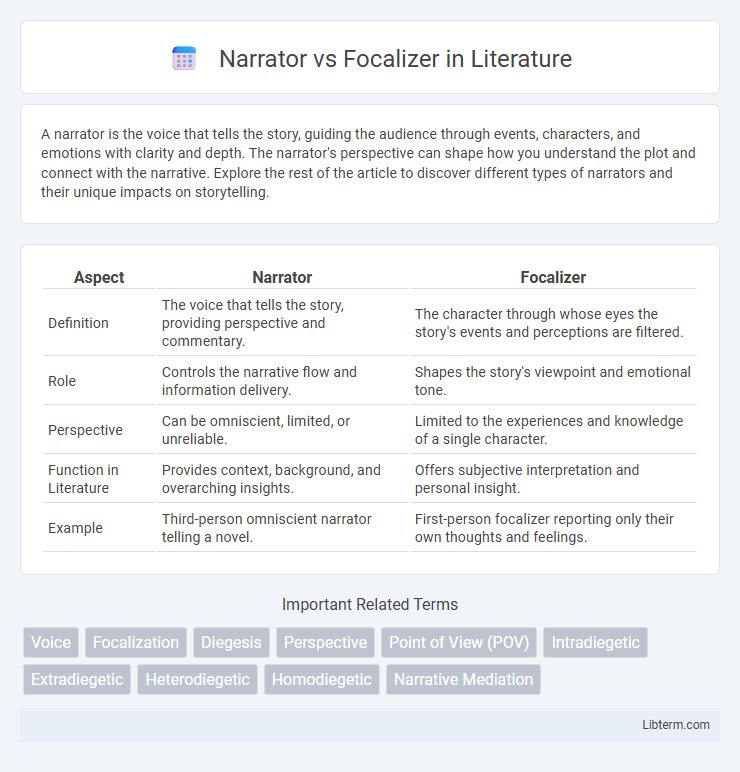A narrator is the voice that tells the story, guiding the audience through events, characters, and emotions with clarity and depth. The narrator's perspective can shape how you understand the plot and connect with the narrative. Explore the rest of the article to discover different types of narrators and their unique impacts on storytelling.
Table of Comparison
| Aspect | Narrator | Focalizer |
|---|---|---|
| Definition | The voice that tells the story, providing perspective and commentary. | The character through whose eyes the story's events and perceptions are filtered. |
| Role | Controls the narrative flow and information delivery. | Shapes the story's viewpoint and emotional tone. |
| Perspective | Can be omniscient, limited, or unreliable. | Limited to the experiences and knowledge of a single character. |
| Function in Literature | Provides context, background, and overarching insights. | Offers subjective interpretation and personal insight. |
| Example | Third-person omniscient narrator telling a novel. | First-person focalizer reporting only their own thoughts and feelings. |
Defining Narrator: Who Tells the Story?
The narrator is the voice that conveys the story to the audience, controlling the flow of information and shaping the reader's understanding. Unlike the focalizer, who filters the narrative through a character's perspective, the narrator may be omniscient, limited, or unreliable, defining the scope and tone of the storytelling. Identifying the narrator involves analyzing narrative voice, point of view, and the degree of insight they possess into characters and events.
Understanding the Role of the Focalizer
The focalizer in narrative theory represents the character through whose perspective the story is perceived, shaping the reader's experience by filtering events and emotions. Unlike the narrator who delivers the overall account, the focalizer controls the internal viewpoint, influencing narrative tone and insight. Understanding the role of the focalizer reveals how subjectivity and limited information affect storytelling and character development.
Key Differences Between Narrator and Focalizer
The key differences between narrator and focalizer lie in their narrative functions and perspectives: the narrator is the voice that tells the story, often providing an overarching, external viewpoint, whereas the focalizer filters the narrative through a specific character's consciousness or perspective. The narrator controls the storytelling distance and scope, while the focalizer limits the narrative to what the chosen character perceives, knows, and experiences. These distinctions affect how information is revealed and shape readers' engagement with the story's events and characters.
Types of Narrators in Literature
Narrators in literature vary widely, including first-person narrators who provide a personal perspective, third-person omniscient narrators who offer an all-knowing viewpoint, and unreliable narrators whose credibility is compromised. The focalizer, distinct from the narrator, controls the narrative perspective by filtering the story through a specific character's consciousness, shaping readers' access to events and emotions. Understanding the types of narrators--such as homodiegetic (story-telling within the story) versus heterodiegetic (external storyteller)--is essential for analyzing narrative structure and the interplay between narrative voice and focalization.
Varieties of Focalization: Internal vs. External
Narrator and focalizer represent distinct narrative perspectives, with the narrator conveying the overall story and the focalizer providing the viewpoint through which events are filtered. Varieties of focalization include internal focalization, where the focalizer's perspective is limited to a character's inner thoughts and feelings, and external focalization, which restricts the perspective to observable actions and external events without access to inner experiences. This distinction shapes how information and emotions are transmitted to the reader, influencing narrative depth and reliability.
How Narrators Shape Narrative Voice
Narrators shape narrative voice by controlling the perspective, tone, and reliability through which a story is conveyed, influencing how readers perceive characters and events. Unlike focalizers, who limit the narrative perspective to a specific character's internal viewpoint, narrators maintain overall authority and determine the scope of information available to the audience. The distinction between omniscient narrators, who provide comprehensive knowledge, and unreliable narrators, who present biased or incomplete accounts, further shapes the narrative's emotional and interpretive depth.
The Focalizer’s Influence on Perspective
The focalizer shapes narrative perspective by filtering events through their subjective experiences, emotions, and biases, which directly impacts the reader's understanding of the story. Unlike the narrator, who may present an omniscient or neutral viewpoint, the focalizer limits the scope of information, emphasizing particular details aligned with their internal perspective. This selective lens creates a more intimate and psychologically complex portrayal of characters and events, driving the narrative's emotional depth and credibility.
Narrator and Focalizer in Classic Literary Examples
In classic literary examples, the narrator serves as the voice guiding readers through the story, often providing an overarching perspective, as seen in Jane Austen's "Pride and Prejudice" with its third-person omniscient narration. The focalizer, by contrast, limits the narrative perspective to a specific character's thoughts and experiences, such as the focalization through Nick Carraway in F. Scott Fitzgerald's "The Great Gatsby," which shapes readers' understanding of the plot. This distinction between narrator and focalizer influences narrative reliability and depth, shaping how the story's events and characters are perceived.
Common Misconceptions: Narrator vs. Focalizer
Common misconceptions about narrator versus focalizer often confuse their distinct narrative functions; the narrator is the voice conveying the story, while the focalizer filters the narrative through a character's perspective. Readers frequently mistake the narrator's knowledge scope for the focalizer's limited viewpoint, overlooking that the focalizer's perception shapes the narrative tone and information access. Understanding this distinction enhances the analysis of narrative reliability and character subjectivity in literature.
Narrative Techniques: Combining Narrator and Focalizer
Narrative techniques that combine narrator and focalizer enrich storytelling by blending external narration with internal perspective, creating a dynamic interplay between objective description and subjective experience. This hybrid approach allows authors to seamlessly shift between an omniscient narrator's overview and a character's intimate viewpoint, enhancing emotional depth and narrative complexity. Prominent examples in literature include Virginia Woolf's "Mrs. Dalloway," where free indirect discourse merges the narrator's voice with characters' consciousness, demonstrating this technique's power to unify narrative authority and focalization.
Narrator Infographic

 libterm.com
libterm.com